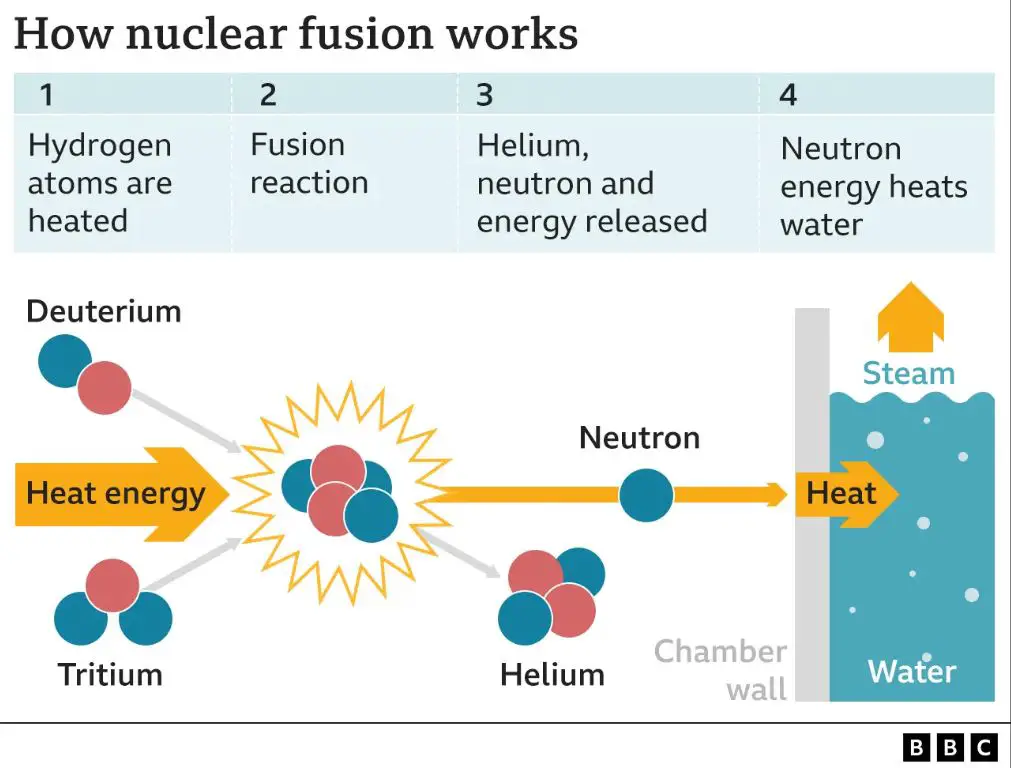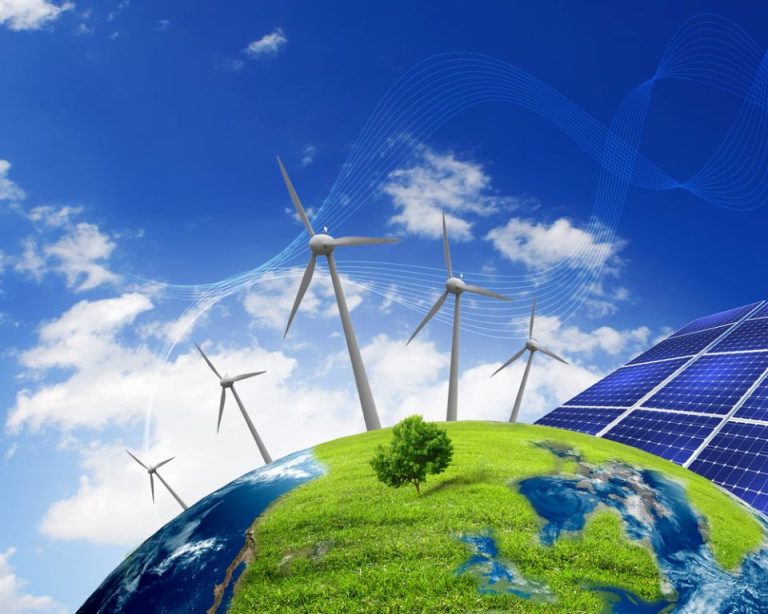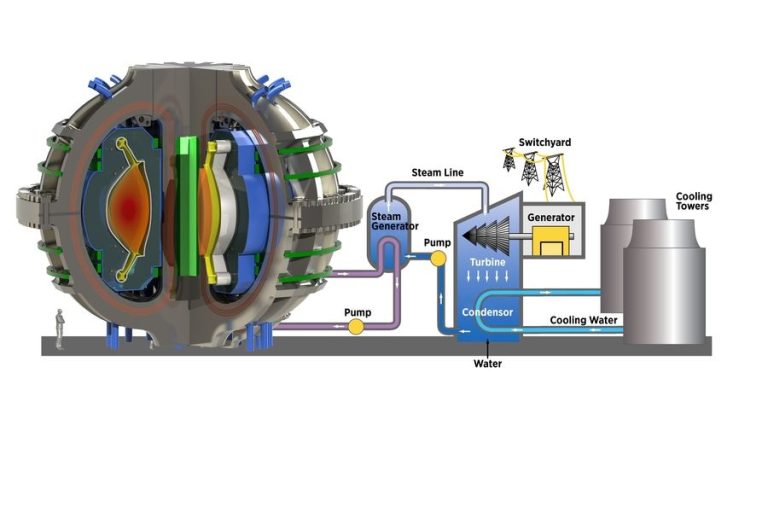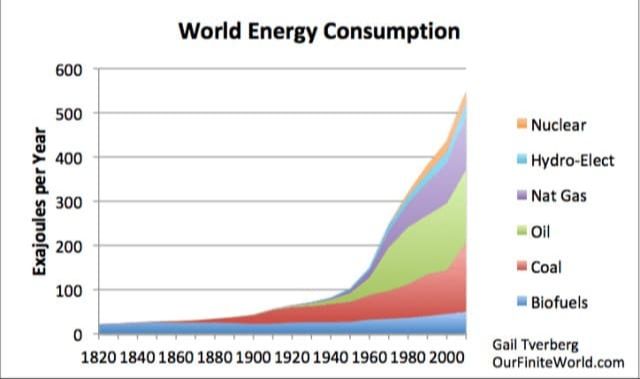How Much Energy Does Nuclear Fusion Produce

Nuclear fusion is a process in which two or more atomic nuclei collide and combine into a new atomic nucleus, releasing energy in the process. Fusion takes place at extremely high temperatures where atoms can collide with enough energy to overcome the electrostatic repulsion between their nuclei. Hydrogen nuclei (protons) can fuse together to form helium nuclei, releasing large amounts of energy in the form of kinetic energy carried by the reaction products.
The most basic fusion reaction combines deuterium and tritium, two heavy isotopes of hydrogen:
D + T → 4He + n + energy
In this reaction, a helium-4 nucleus and a neutron are produced, and 17.6 MeV of energy is released. The extremely high temperatures and pressures required to force nuclei close enough together for fusion reactions to occur only exist naturally in stars like the Sun. On Earth, scientists try to replicate and control fusion reactions at scale in experimental fusion reactors.
Fusion differs from nuclear fission, in which a heavy atomic nucleus like uranium splits into two smaller nuclei. Fusion reactions release 3-4 times more energy per reaction than fission. However, fission reactions are easier to achieve and have been used in nuclear power plants for decades. Fusion power remains experimental but offers potential advantages over fission, like less radioactive waste.
For over 60 years, scientists have worked toward achieving controlled fusion reactions that release net energy and could be used for power generation. While significant progress has been made, challenges remain. The largest experimental fusion reactor, ITER in France, is not expected to achieve a net energy gain until the 2030s. Ongoing fusion research focuses on confining the reacting plasma, generating sufficient plasma density and temperature, and extracting fusion energy.
Potential Benefits of Fusion
Nuclear fusion has several potential benefits that make it an appealing energy source for the future:
Virtually limitless fuel source – Fusion reactions use isotopes of hydrogen as fuel, which are abundant in seawater. According to the Culham Centre for Fusion Energy, there is enough deuterium in the ocean to provide energy for millions of years [1].
No long-lived radioactive waste – Fusion reactions produce little radioactive waste compared to nuclear fission. Any waste products have short half-lives, reducing radioactivity quickly [2].
No risk of meltdown – It is difficult to sustain fusion reactions, so they stop by themselves if conditions are disrupted. This makes meltdowns virtually impossible.
No carbon emissions – Fusion does not burn fossil fuels and does not produce greenhouse gases or carbon emissions.
Challenges of Nuclear Fusion
Nuclear fusion faces significant scientific and engineering challenges that make it difficult to achieve in practice. Some of the main challenges include:
Extremely high temperatures needed – Fusing atomic nuclei requires heating fuel, typically hydrogen isotopes like deuterium and tritium, to temperatures exceeding 150 million°C. This is over 10 times hotter than the core of the sun and hotter than any place in the known universe. Heating fuel to these extreme temperatures presents enormous challenges.
Maintaining stable plasma – At such high temperatures, the hydrogen fuel exists in a state of matter known as plasma. Plasma is unstable and difficult to control and contain. Keeping the plasma stable long enough for sufficient fusion reactions to occur has proven enormously difficult so far (Source).
Achieving net energy gain – For fusion power to be viable, the amount of energy gained from fusion reactions must exceed the energy required to heat the fuel and run the reactor. So far, no fusion experiment has achieved net energy gain. ITER, a large international fusion project under construction, hopes to be the first to do so.
Engineering challenges – The extreme conditions inside fusion reactors require advanced materials and technologies that can withstand the high temperatures and radiation. Developing suitable materials, controlling the plasma, generating sufficient tritium fuel, and extracting the heat are all cutting-edge engineering challenges (Source).
How Much Energy Does Fusion Produce?
Nuclear fusion reactions release an incredible amount of energy relative to the mass of the fuel involved. This is referred to as the energy density of the reaction. According to Wikipedia (https://en.wikipedia.org/wiki/Nuclear_fusion), fusion reactions have an energy density many times greater than nuclear fission. The energy released per kilogram of fuel in a fusion reaction is over four times greater than for fission reactions used in nuclear power plants.
To put this in perspective, the IAEA reports that fusion could generate nearly four million times more energy per kilogram than burning coal (https://www.iaea.org/newscenter/news/what-is-nuclear-fusion). This vast energy output is because fusion directly converts mass into energy based on Einstein’s famous equation E=mc^2. In comparison, burning fossil fuels relies on chemical reactions between the electrons in molecules, which is a much less efficient process.
Specifically, fusing just one kilogram of deuterium fuel has the potential to produce 1012 joules of energy, which is equal to 275 million kcal. This tremendous energy density is why nuclear fusion is being pursued as a potentially revolutionary new energy source that could provide vast amounts of power with minimal fuel input.
Fusion Reactions
There are two main fusion reactions that have been studied for fusion power generation: deuterium-tritium (D-T) fusion and deuterium-deuterium (D-D) fusion. The key difference between D-T and D-D fusion is the elements involved in the reaction.
In D-T fusion, deuterium and tritium nuclei fuse together to form a helium nucleus and release a neutron. This can be represented by the following equation:
D + T → ^4He + n + 17.6 MeV
The products are a helium nucleus (^4He), a free neutron, and 17.6 MeV of energy. The high energy yield makes D-T fusion appealing for power generation.
In D-D fusion, two deuterium nuclei fuse together to form a ^3He nucleus and a proton, with 3.27 MeV of energy released. The equation is:
D + D → ^3He + p + 3.27 MeV
The lower energy yield of D-D fusion means it is less suitable for power production than D-T fusion. However, D-D fusion may play a role in a fusion power plant to breed tritium from lithium.
Both D-T and D-D fusion require extremely high temperatures and pressures to overcome the repulsive forces between the positively charged nuclei. This is achieved by heating hydrogen isotopes into a plasma state at over 100 million degrees Celsius.
Energy Gain in Fusion
The amount of energy produced from fusion reactions compared to the amount of energy required to initiate the reactions is given by the Lawson criterion. The Lawson criterion states that the product of the ion density (n) and the energy confinement time (τE) must exceed a value for net energy gain, expressed mathematically as nτE ≥ 1–2 × 1014 s/cm3 for deuterium-tritium reactions at a temperature of 10-20 keV (1). This essentially means that fusion reactions need a high enough density of ions confined for long enough time to produce more energy than is required to heat and contain the plasma. The energy gain factor, Q, is the ratio of fusion power produced to input power required. Scientific breakeven corresponds to Q ≥ 1, when the fusion power produced equals the power put into the reactor. A Q value of at least 10 will be required for a commercial fusion reactor (2).
The International Thermonuclear Experimental Reactor (ITER) currently under construction aims to achieve Q ≥ 10. ITER seeks to produce 500 MW of fusion power from 50 MW of input power, corresponding to Q = 10. This will be a significant milestone toward demonstrating the feasibility of fusion energy (2).
In summary, the Lawson criterion determines the conditions needed for net energy gain from fusion. While scientific breakeven occurs at Q = 1, commercial fusion reactors will require substantially higher Q values of 10 or more for net electricity production. ITER’s goal is to experimentally achieve such high gain values for the first time.
(1) Lawson criterion
(2) Lawson Criteria for Nuclear Fusion
Fusion Reactors
There are two main approaches to achieving nuclear fusion in a reactor: magnetic confinement and inertial confinement. In magnetic confinement, strong magnetic fields are used to contain the hot fusion plasma. The most common designs are tokamaks and stellarators. In inertial confinement, lasers are used to rapidly compress and heat fusion fuel to extreme temperatures and densities. Major inertial confinement projects include the National Ignition Facility (NIF) in the United States.
The tokamak is the most developed magnetic confinement design and uses a toroidal (donut-shaped) chamber. Powerful magnets confine the plasma inside the tokamak while current driven through the plasma helps provide additional stability. The Joint European Torus (JET) in the UK holds the record for fusion energy output from a tokamak. The International Thermonuclear Experimental Reactor (ITER), currently under construction in France, aims to demonstrate the feasibility of fusion energy and produce 10 times more power than it consumes.
Stellarators are an alternative magnetic confinement design that use a twisted toroidal shape and magnetic coils to achieve plasma stability without a current. The largest stellarator project is the Wendelstein 7-X in Germany, which successfully confined a hydrogen plasma for up to a minute.
At the NIF, lasers rapidly compress a small pellet containing fusion fuel to extremely high temperatures and pressures. In 2021, NIF achieved a fusion yield higher than its input laser energy for the first time. However, generating continuous fusion with laser inertial confinement has proven challenging.
Future Outlook
Timeline for fusion energy: When it comes to developing sustained nuclear fusion energy, significant progress has been made but major hurdles remain. Most experts believe commercial fusion energy is still likely decades away. Guesstimates of the timeline for fusion energy range from the 2030s to 2080s, with many citing 2050 as a common target (https://www.gao.gov/products/gao-23-105813). However, breakthroughs and accelerated timelines are possible given the rapid pace of development and discoveries in fusion technology.
Recent promising developments: In recent years, progress in fusion energy has accelerated with several promising developments. In 2021, scientists at the National Ignition Facility produced over 1MJ of fusion energy output for the first time. In 2022, UK company Tokamak Energy announced it activated a fusion reactor reaching 100 million degrees Celsius. Major fusion experiments like ITER are also continuing to hit project milestones. Private companies like Commonwealth Fusion Systems, Helion Energy and TAE Technologies have raised hundreds of millions in funding and aim to build the first commercially viable fusion reactors.
Role of fusion in clean energy future: If sustained fusion power becomes a reality, it could play a major role in the global clean energy transition and reducing greenhouse gas emissions. Fusion holds advantages over current fission reactors as it produces no long-lived radioactive waste, boasts unlimited and widespread fuel (deuterium) and avoids the risks of nuclear meltdown. The promise of safe, clean and abundant energy makes fusion an appealing option to displace fossil fuels and complement renewables like solar and wind in a carbon-free energy system (https://www.scientificamerican.com/article/what-is-the-future-of-fusion-energy/).
Additional Applications
While fusion is mainly being researched as an energy source for electricity production, it does have some additional applications that are worth noting.
One application is in nuclear weapons. Fusion reactions are used in hydrogen bombs to create massive explosions. However, the conditions needed for fusion in bombs are very different than those in fusion power plants. Power plants operate with controlled, sustained reactions, while bombs rely on uncontrolled chain reactions.
Fusion could also potentially be used for spacecraft propulsion. Fusion reactions generate high energy particles that could be directed out a nozzle to produce thrust. This could enable much faster space travel compared to current chemical rockets. Fusion propulsion may one day allow for efficient transportation for deep space missions.[1]
In industry, fusion could be applied in neutron generators for applications like materials analysis. The neutrons produced in fusion can help reveal the structure and composition of materials. Fusion may also have medical applications in neutron capture therapy, where neutron irradiation is used to treat certain cancers.[2]
While producing electricity is the main goal for fusion, its unique properties open up several additional promising applications in weapons, space travel, manufacturing, and medicine.
[1] https://www.iaea.org/newscenter/news/what-is-nuclear-fusion
[2] https://science.howstuffworks.com/fusion-reactor6.htm
Conclusion
In summary, nuclear fusion has the potential to provide an immense amount of clean, sustainable energy with less radioactive waste than current fission reactors. The amount of energy produced through fusion reactions is astounding – over five million times more than the input energy. While there are still engineering challenges to overcome, fusion represents one of the most promising options for energy production in the future. Continued research and development of fusion technology is critical if we want to realize this potential. If scientists can harness fusion on a commercial scale, it would be transformative for meeting global energy needs while combating climate change. The possibilities of fusion energy are bright, and it warrants substantial investment today to make it a reality tomorrow.




